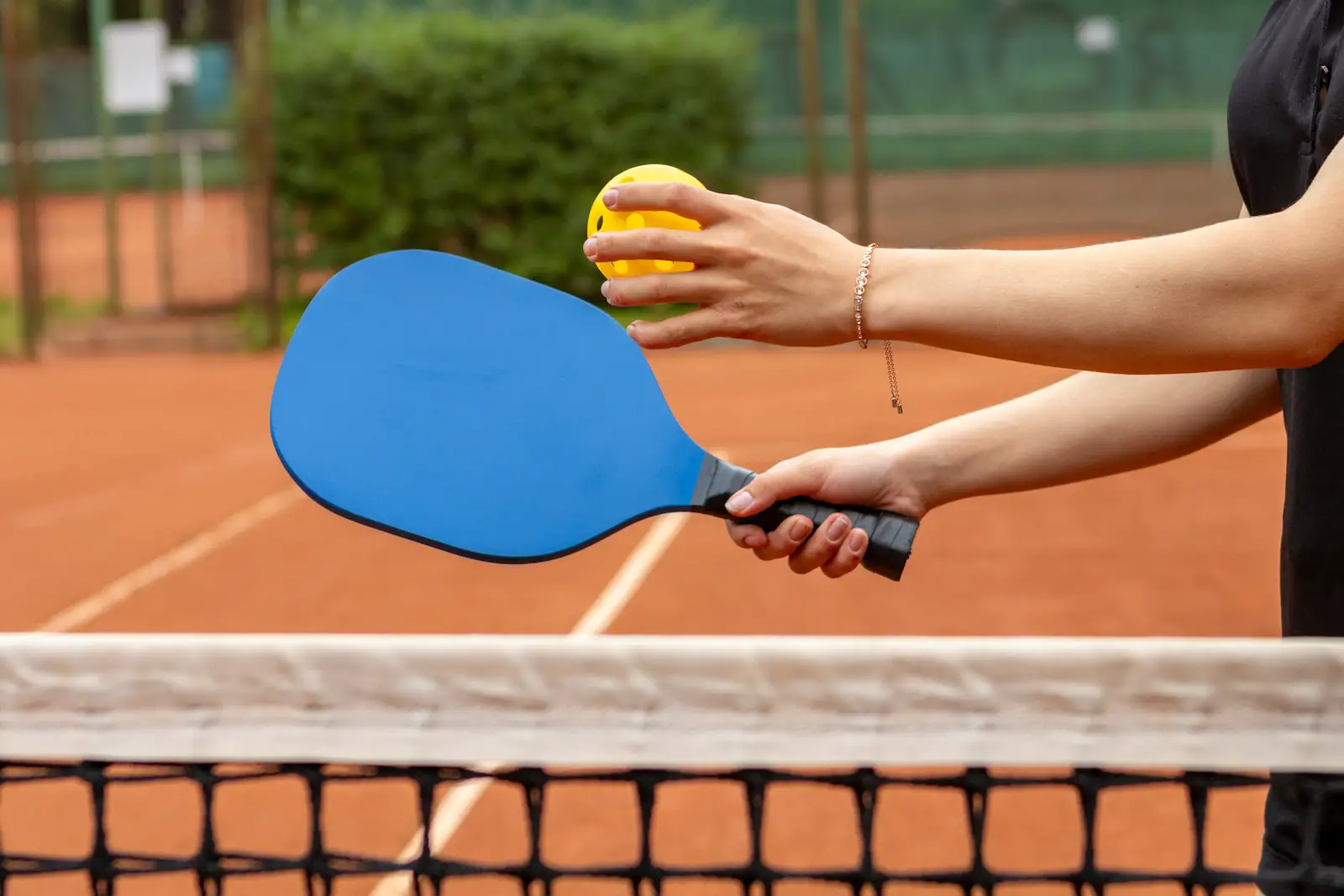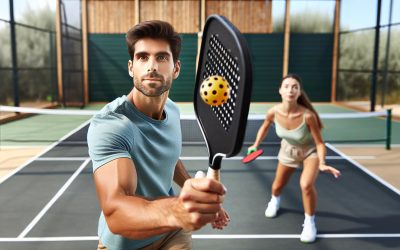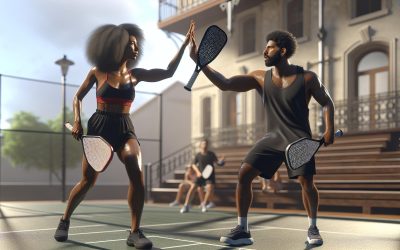If you’re into pickleball like I am, you’ve probably heard about the dink shot. It’s a clever little move that can completely change the game’s dynamics. But what exactly is a dink in pickleball? And more importantly, how can you master it?
The dink shot is all about strategy. It’s a soft, low shot that’s aimed right over the net, ideally landing in the opponent’s non-volley zone. The goal is to keep your opponent at bay, limiting their power and control over the game.
Mastering the dink shot isn’t just about technique. It’s about understanding your opponent, predicting their moves, and using the dink shot to disrupt their game plan. Stay tuned as we delve deeper into the art of the pickleball dink.
What is a Dink in Pickleball?
The dink in pickleball, it’s more than just a funny term. It’s a strategically significant shot that can drastically alter the course of the game. So, what exactly is a dink shot?
In the simplest terms, it’s a soft, short shot that’s designed to sail just over the net, landing in the opponent’s non-volley or kitchen zone. The chief aim of this shot is to keep the ball low, effectively rendering your opponent’s power and control useless.
Contrary to the power shots in pickleball, the dink shot isn’t about speed or force. It’s all about precision, patience, and predictability. It sets up a slow-paced rally, forcing your opponent to remain at the kitchen line. This strategy effectively limits their ability to utilize power or smash shots.
Mastering the dink shot involves a pair of essential elements: understanding your opponent and predicting their moves. By studying your opponents, their habits, and tendencies, you can successfully predict their reactions. With this knowledge, you are then able to use the dink shot to disrupt their game plan, leaving them devoid of counter attack options.
Another critical aspect of the dink shot is its use as a defensive tool. A well-placed dink can help even when you’re under pressure, providing time to regroup and reset the point.
That’s what a dink shot in pickleball is, and that’s just the tip of the iceberg. A strategic pickleball game goes far beyond the mastery of individual shots. It requires constant learning, adapting, and evolving your game to outsmart your opponent at every turn. In the subsequent sections, we’ll delve further into the mechanics of the dink shot and how to wield it effectively in your games.
The Importance of the Dink Shot
Discovering the true potential of the dink shot can reshape your entire pickleball strategy. Remember, it’s not just an adornment to your game, but a powerhouse move that can be a real game-changer. The moment you start underestimating the dink shot, you’re giving your opponents the advantage. So let’s delve into why the dink shot is so crucial.
One major importance of the dink shot is its ability to deflate the opponent’s power. In high energy games, players often rely on powerful smashes and speedy shots. Here, a well-placed soft shot can throw them off balance. By keeping the ball low and just over the net, the dink shot restricts your opponents from using their power. This will keep them guessing and force them to adapt to your game, instead of you playing into theirs.
Secondly, the dink shot buys you time. In a high-paced game, every second counts. A well-executed dink can keep the ball in play, allowing you and your partner to regroup, strategize and prepare for the next shot. The ability to control the pace of the match gives you an upper hand.
Lastly, the dink shot is your weapon for disrupting the opponent’s game plan. No matter how well an opponent can drive, smash, or serve, an unexpected dink can rattle them. It forces them to shift uncomfortably close to the net, maneuver out of their stronghold, and respond to your precision-based gameplay. It’s about using the predictability of the dink shot to your advantage.
So, as you can see, the dink shot is far from a filler move in pickleball. It’s a unique blend of unpredictability and precision that can be a deciding factor in tightly contested matches. But to make this work, you need to practice, learn, and evolve constantly. And that’s how you’ll master the strategic element of pickleball. It’s truly about brains over bronze in this sport. Embracing that fact can lead you beyond what you thought possible.
How to Master the Dink Shot
Mastering the dink shot is no child’s play. Consistency, control, and placement are the three C’s you must abide by. So, let’s delve into the ‘how’ part.
Firstly, to maintain consistency, it’s all about practice. The more dinks I hit, the better I become.
Just remember:
- A Dink shot isn’t about speed.
- It’s all about making sure that my shot is consistent and lands within the non-volley zone.
- Consistent practice helps me improve my reflex, timing, and touch.
Next is control. It’s about having the ability to control my paddle movement. Guiding the ball precisely where I want it to land. Wow factor or speed isn’t what dinking is about. It’s about the agonizingly slow pace of the ball that deflates the opponent’s power.
Lastly, we’ve got placement. This is where the strategy kicks in. The aim should be to keep my opponent off balance. The keyword here is unpredictability. I shouldn’t always aim for the same spot. Sometimes, I aim for their backhand, sometimes the forehand. Keep them guessing, keep them on their toes.
Table 1: ‘Three C’s of mastering dink shots’
| Consistency | Control | Placement |
|---|---|---|
| Consistent practice | Paddle movement control | Smart and unpredictable positioning |
In a pickleball game, clever strategy outshines brute strength. And a well-placed dink shot is a testament to this fact. Mastering it might require patience, but it’s truly a game-changer. Remember, a good player knows how to smash. A great player however, knows when to dink.
Understanding Your Opponent
To truly master the dink shot, it’s crucial not only to hone your skills, but also to understand your opponent. An individual’s playing style, strengths, and weaknesses play an integral part in pickleball. Being able to anticipate an opponent’s movement, knowing where they’ll likely place their shot, enhances the effectiveness of our dink shot strategy.
One method that helps players is observing opponent techniques during warm-up. Watch carefully for any patterns or habits. Some players have a consistent response to certain situations, while others might often favor one side over another. Through observation, we pick up on these habits and use them to our advantage.
Let’s consider the importance of unpredictability in dinks. An opponent’s dink response often relies on anticipating your dinks, predicting your next move. If you mix up your shots, vary their speed and direction, confuse your opponent by keeping them guessing. Unpredictability is a cornerstone of a strong dinking strategy.
Quick reactions and adaptability are equally important when dealing with unpredictable dinks. Enhancing these skills enables us to respond to unexpected situations, increasing our chances of winning. Remember, practice is key to improvement – the more you play, the faster your reactions and adaptability will become.
Even when we’ve grasped all these concepts, we cannot forget the importance of endurance and patience. Pickleball is as much a mental game as it is physical. We not only need to outsmart our opponents with dinks, but also maintain our patience during long rallies, wear them down and wait for the right opportunity to strike.
It’s ultimately critical to remember that dinking is not merely an isolated skill. It’s a piece of the larger strategic puzzle in the game of pickleball which includes understanding your opponent, patience, practice, and a healthy dose of unpredictability.
Disrupting Your Opponent’s Game Plan
Getting under your opponent’s skin is an effective way to dominate any pickleball game. The dink shot plays a crucial role in this strategy. Once you’ve studied your opponent’s game plan, the dink shot helps you disrupt it. It’s all about unpredictability, quick reactions, and adaptability.
Let’s consider that you’re up against a power-player who feeds off fast shots and rallies. They’re at their best when the ball is flying back and forth rapidly. Precision, patience, and the dink shot can pull them out of their comfort zone. A well-executed dink shot forces them to move closer to the net and compels them to play at your pace.
Next, picture a situation where you’re dealing with an opponent who loves to control the net area. Firing a dink shot in unpredictable patterns may fluster them. It limits their court control as they’ll be scrambling to handle your dinks.
But let’s be clear, it’s not easy, and it’s not meant to be. You’ll miss, you’ll err, and at times, you may even suffer an out-of-turn defeat. That’s where the element of practice and endurance comes in.
Keep these things in mind while practicing your dink shots:
- Unpredictability: Stretch your creativity. Send the ball in random patterns, make the shots less predictable.
- Don’t rush: Patience pays off in dinking. A rushed dink usually gives the opponent an easy put-away opportunity.
- Variety: Don’t just limit yourself to forehand dinks. Practice backhands and different angles to add variety to your game.
Understanding and implementing these strategies can significantly enhance your pickleball game. Don’t be afraid to step out of your comfort zone and shake up your pickleball strategy. Revamping your approach can be the missing piece in your game’s strategic puzzle. The path to pickleball prowess might not always be easy, but with patience and practice, it’s certainly attainable. Remember, the dink shot isn’t just a skill, it’s a strategic weapon if used correctly.
Conclusion
Mastering the dink shot has the potential to elevate your pickleball game to new heights. It’s not just about the shot itself, but the strategy behind it. Knowing your opponent and adjusting your game play accordingly can make all the difference. Keep them guessing with unpredictable dinks and adapt quickly to any unexpected moves. Remember, patience is key – don’t rush your shots. Practice makes perfect, so don’t shy away from putting in the time to hone your dink shot skills. Variety in your dinking strategy can disrupt your opponent’s game plan, giving you the upper hand. The dink shot isn’t just a move, it’s a strategic weapon, and when used correctly, it can be a game changer. Here’s to you, and your journey to becoming a dink shot pro!














0 Comments